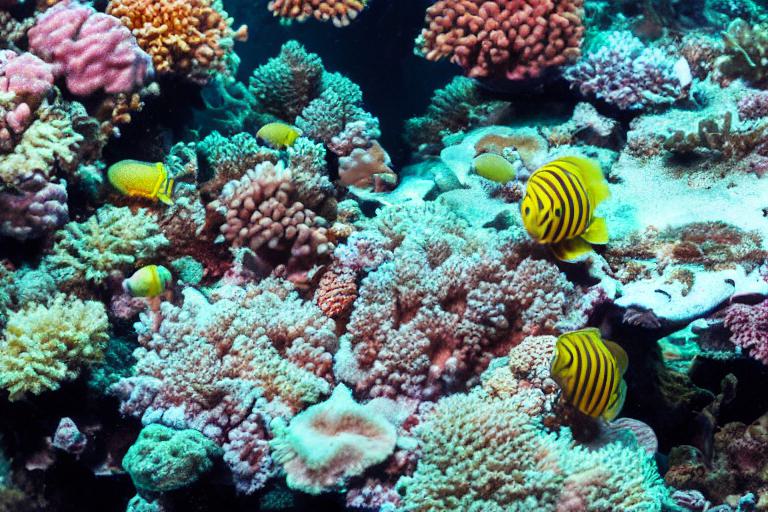Coral bleaching is a serious problem for reef tanks. The causes can be many, ranging from water quality issues to disease. But, there are some things that can be done to help prevent or even reverse the process.
Why Do Corals Bleach?
This is usually caused by stress from things like changes in water temperature, pollution, or even too much light. Corals are very sensitive to changes in their environment, and one of the biggest threats to their health is bleaching. When corals bleach, they lose their color and turn white.
If you have a reef tank, make sure to keep a close eye on your water quality and temperature, and take steps to reduce stressors like pollution and excessive light exposure. Bleaching is a serious problem for corals, and it can often lead to death. That’s why it’s so important to try to prevent it from happening in the first place.
A brief explanation of how corals discolor.
This can be a response to a variety of stressors, including changes in water temperature, light, and salinity. Coral bleaching is the process by which corals expel the algae that live inside their tissues, causing them to turn white. While bleaching is often fatal to corals, it can also give them a chance to recover if the stressor is removed.

Reef Tank Water Quality & Coral Bleaching
Poor water quality can lead to coral bleaching, a condition in which corals lose their color and eventually die. Reef tank water quality is a major factor in the health of corals and other marine life.
When water temperatures rise, corals expel the algae that live inside their tissues, causing them to turn white. There are many causes of coral bleaching, but the most common is high water temperatures.
The best way to do this is to maintain stable water conditions and avoid sudden changes in temperature, salinity, and pH. Bleached corals are more susceptible to disease and death, so it’s important to take steps to prevent bleaching in your reef tank.
With proper care, your bleached corals can recover and your reef tank can thrive. If you do see signs of bleaching in your tank, take immediate action to improve water quality and stability. This may include adding more live rock or changing the way you feed your corals.
Tips on Lightning and Filtration to Prevent Coral Bleaching
Coral bleaching occurs when the coral loses its symbiotic algae, which provide the coral with food and give it its color. Without the algae, the coral becomes pale or white. Coral bleaching is one of the most serious threats to the health of coral reefs.
One of the most common causes of coral bleaching is exposure to high levels of light. Coral bleaching can be caused by many things, including changes in water temperature, light, or chemistry. This can happen when the water in a reef tank is too clear, or when the tank is placed in a sunny window.
To prevent coral bleaching, it is important to maintain proper water conditions in your reef tank. The water should be neither too hot nor too cold, and the level of filtration should be appropriate for the size of the tank. It is also important to avoid sudden changes in water conditions, which can stress the coral and lead to bleaching.
If you notice that your coral is beginning to bleach, there are some things you can do to help. You can also try to increase the amount of light the coral is receiving, or add more algae to the water. If the bleaching is severe, you may need to remove the coral from the tank and place it in an aquarium with more favorable conditions. First, check the water conditions in your tank and make sure they are within the proper range.
Frequently Asked Questions
1. What is coral bleaching?
Coral bleaching is when coral loses its color and turns white. This can be caused by many things, including stress from changes in water temperature, light, or chemistry.
2. Why does coral bleach?
Coral bleaches to protect itself from stressors in the environment, like changes in water temperature, light, or chemistry.
3. What are the consequences of coral bleaching?
Coral bleaching can lead to the death of the coral. When coral dies, it breaks down and provides food for other animals in the reef. This can lead to a decrease in the number of fish in the reef, and an overall decrease in the health of the reef.
4. How can I prevent coral bleaching in my reef tank?
There are a few things you can do to prevent coral bleaching in your reef tank. First, make sure to slowly acclimate new coral to your tank. Second, maintain stable water parameters in your tank. And finally, provide your coral with adequate lighting and water flow.
5. What should I do if my coral starts to bleach?
If your coral starts to bleach, the first thing you should do is remove any stressors in the environment, like changes in water temperature, light, or chemistry. You can also try to slowly acclimate the coral to your tank. If the coral continues to bleach, you may need to remove it from your tank.
Final thoughts
Coral bleaching can be a big problem in reef tanks if not caught early and treated properly. There are a few things that can cause coral bleaching such as, high water temperatures, high light levels, and high levels of dissolved organic carbon. If you think your coral is bleaching, the first thing you should do is check the water parameters and make sure everything is in line. If the water parameters are good, then you can try to acclimate the coral to the new conditions slowly. If the coral is still not doing well, then you may need to remove it from the tank and place it in a holding tank with better conditions.
